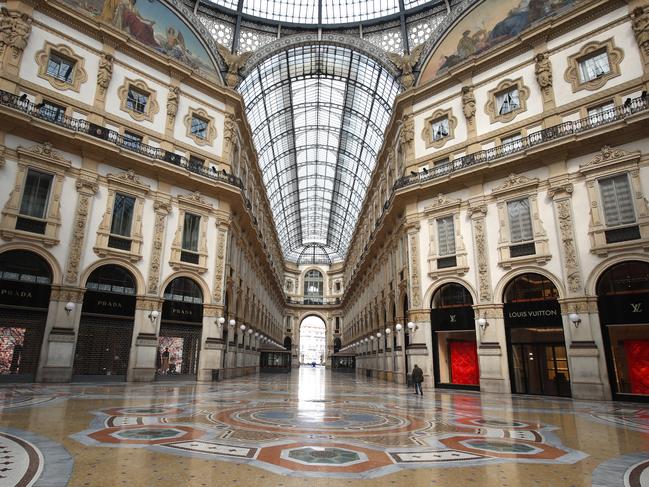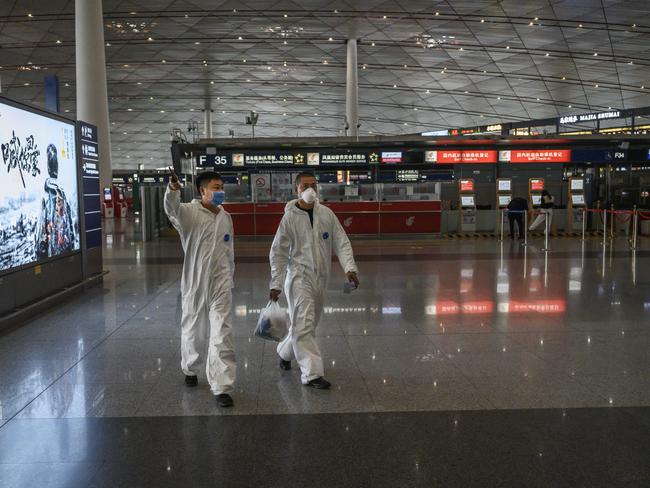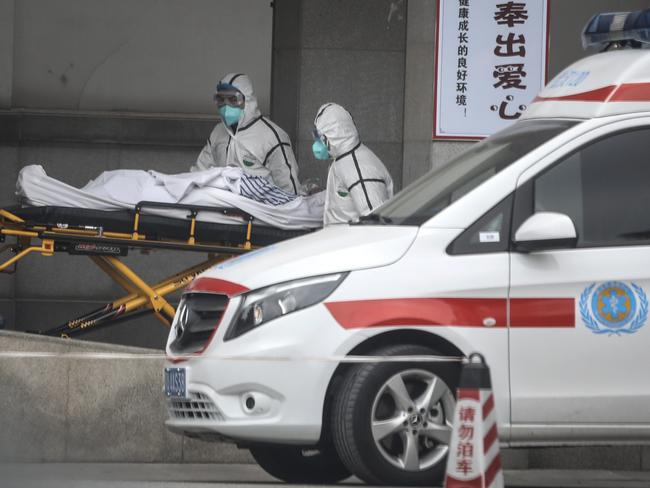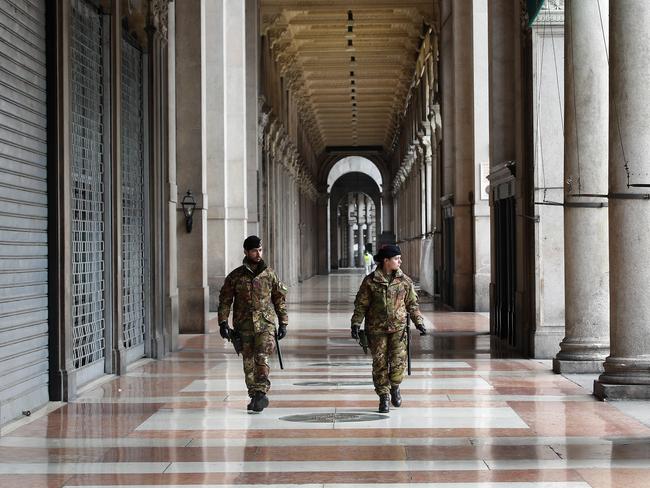Patient zero: How the coronavirus became a pandemic
It’s sparked global lockdowns and wreaked havoc on economies while infecting hundreds of thousands of people across the world. And the coronavirus pandemic is thought to have began after it jumped from animals to this one person.
Health
Don't miss out on the headlines from Health. Followed categories will be added to My News.
- Three health funds won’t axe price hikes before next week
- Aussie market is up for fourth day, as Wall St rebounds
Before it became a global pandemic, infecting more than 520,000 people and claiming 23,500 lives, the novel coronavirus was a mysterious lung infection affecting mainly those who worked at a filthy market in the Chinese city of Wuhan.
The staff at the Huanan Seafood Wholesale Market in the teeming central city of Wuhan were poorly paid, and when they became ill, they couldn’t afford a visit to the modern hospitals in the city centre.
Instead, they mostly went to local clinics tucked away in the backstreets around the market in the Jianghan district, north of the Yanghtze River. By the time they were sick enough to be taken to the major hospitals, they’d unwittingly spread the disease to their family and their neighbours. And so, a pandemic was born.


No-one knows precisely who Patient Zero is, the very first person infected when the virus now known as COVID-19 jumped from animals – likely via bats to civets – onto humans.
But leaked data seen by the South China Morning Post indicates it may have been a 55-year-old resident of Hubei, who was recorded with the mysterious lung infection on November 17.
The Post, a respected English-language newspaper published in Hong Kong, is owned by internet retail entrepreneur, the billionaire Jack Ma, China’s richest man and a member of the Chinese Communist Party. It enjoys freedom to publish stories which would never see the light of day on mainland China.
According to the article published on March 13, data compiled by the Chinese Government shows the very first case recorded in Wuhan was the anonymous 55-year-old, a resident of Hubei province. It is not known publicly if they are male or female, or if they lived or died.
The first nine cases to be reported in November involved four men and five women. None can be positively identified as Patient Zero. All, according to the Post, were aged between 39 years and 79 years.
According to the report, the data shows from November 17 onwards, one to five new cases of the lung infections were being reported every day, at hospitals around Wuhan with a total of 60 cases recorded by December 20.
The raw data, which was not published by the Post, is being used by Chinese scientists to track the early days of the outbreak, which was not declared to the World Health Organisation until December 31, fully six weeks after the baffling cases first emerged.

News Corp has tracked the first cases of the novel coronavirus reported outside of China, which started to show up in mid-January – two months after the first cases arrived in hospitals in Hubei province.
The first diagnosis was in Thailand, when a 61-year-old Wuhan resident arrived at Bangkok’s international airport on January 8 with a high temperature, which was picked up by screening. She had not been to Huanan market but had visited other similar markets around the city, and had fallen ill in Wuhan on January 5, before boarding the flight to Thailand. The Ministry of Public Health said she was taken straight to hospital and diagnosed with COVID-19 on January 13.
The second confirmed case in Thailand also involved a woman from Wuhan, and the third case was an 18-year-old man, also from Wuhan, as was the fourth case, a 68-year-old man from Wuhan.
Wuhan, the capital of China just 100 years ago, is a wealthy, modern city of 11 million people, many of them highly mobile. The Wuhan Tianhe International Airport has direct flights to the leading cities of the world, including New York, Rome, Sydney, Bangkok, London, Tokyo and Paris.
Journalists and academics used anonymised mobile phone usage data and IP addresses to track citizens’ movements and discovered five million Wuhan residents travelled abroad in December and January.
By mid-January, many of them had unwittingly spread the highly-contagious virus across the globe.


On January 16, another Asian neighbour, Japan, reported a diagnosis of coronavirus in a 30-year-old Chinese man, who travelled to Wuhan before arriving in Japan.
Four days later, the United States reported its first case of coronavirus, in a 35-year-old Chinese man who was resident in the US. He had visited Wuhan before returning to his home in Washington State.
Direct lines were being drawn between the virus epicentre, Wuhan, and infections across the world.
Perhaps surprisingly for a country so well connected to China, Australia’s first case didn’t emerge until January 25, when a man from Wuhan fell ill in Victoria. He had flown into Melbourne from the Chinese province of Guangdong on January 19.
The first cases were detected in Italy on January 29 when two Chinese tourists fell ill in Rome. They had flown into Milan on a tour on January 23.
The diagnoses prompted Prime Minister Giuseppe Conte to immediately announce a ban on flights from China – the first country to do so – and declare a six-month state of emergency.
But there was squeamishness from some quarters about the tough action, and the Mayor of Florence, Dario Nardella, launched a “hug a Chinese’’ day on February 1, calling for “unity in the common battle’’ and decrying racism against Chinese people in Italy.
The move prompted Italians to hug Chinese people in the northern Italian city and post images on social media.
Italy is now suffering one of the worst coronavirus tragedies on the planet, with around 80,000 infections, and 8215 people have died, giving the country a death rate of around 10 per cent. More people have died in Italy than in China.

On January 31, the United Kingdom recorded its first cases in a Chinse student and his mother, who were staying in a hotel in the city of York. The UK has still not banned flights from China. Australia banned them on February 1.
A 50-year-old IT consultant, Daren Bland, is currently undergoing coronavirus testing. He returned to the UK on January 19 from the Austrian ski resort of Ischgl, which has been the centre of a coronavirus cluster. If he tests positive, it will mean the virus was in the UK around 10 days before the tourists tested positive.
Alongside the hunt for the Wuhan Patient Zero, scientists are still searching for conclusive proof that the Huanan Seafood Wholesale Market was ground zero for the virus.
A zoonotic virus, it likely jumped from animals to humans at a wet market, where exotic animals are kept alive alongside other animals which are butchered for meat, as SARS did in 2002-2003.
Many of the first patients who showing up at hospitals in Wuhan worked or regularly visited the Huanan market, making it the prime suspect.
Embarrassed Chinese officials have tried to deflect blame, with Foreign Ministry spokesman Zhao Lijian pushing a conspiracy theory that the United States, China’s economic and strategic rival, might have used its military to bring the virus to China.
“It might be US army who brought the epidemic to Wuhan. Be transparent! Make public your data! US owe us an explanation!’’ he tweeted on March 13.

Hundreds of athletes from the US military were in Wuhan for the Military World Games in October 2019, weeks before the first known cases emerged there, and US experts are now looking at whether some cases listed in the US as influenza were actually early, undetected COVID-19 cases.
Infectious diseases expert, microbiologist Peter Collignon, told News Corp there was no doubt in his mind the virus started in Hubei, most likely Wuhan.
Collignon, professor at the Australian National University’s medical school, said the virus had spread to many other provinces in China. He said the virus appeared to have gained a foothold some time before it was identified.
“I think in retrospect you look at the people in hospitals and they weren’t allowed to report it,’’ he said.
“It’s been there (in Wuhan) since at least December, maybe even earlier because they were having lots of deaths in hospitals that were suppressed.’’

Prof. Collignon said most cases in Australia remained directly connected to returning travellers, and there was still not major community transmissions here. People were now bringing the virus in mainly from Europe and the US, he said.
“Australia put up a ban on Chinese travel which was not met with joy by a lot of people, and Europe didn’t basically, and that probably contributed to the spread within those countries,’’ he said.
“It sounds unfair to target individual countries and in retrospect we should have targeted the US ourselves much earlier.
“Even in the US it must have been spreading there much longer and went undetected because it just looked like another respiratory tract infection.’’
Prof. Collignon said COVID-19 had been reported in many parts of China, but not across the entire country.
“Beijing had thousands of cases and so did Shanghai. But it didn’t spread rampantly through the whole country,’’ he said.
“If this was influenza, put up your hands and say ‘forget it’.
“If you look at swine ‘flu, (2009 pandemic) as far as I am aware no country was able to stop it spreading in their country.
“This one’s a bit different because so far we haven’t had a lot of community spread in Australia despite having had cases here since January.’’
Originally published as Patient zero: How the coronavirus became a pandemic


